We are entering the next phase of Twitter’s maturity. With the IPO completed, it now has enough market validation and cash to be accepted as a valid advertising vehicle by major brands and the rapidly evolving Social TV industry. These are great targets for advertising, but there is another market that I see emerging over the next couple of years. I call this Vertical Twitter.
There are some features that all Twitter business users and advertisers need: targeted leads, high click-thru rates on URLs in tweets, and high numbers of quality followers. There are now good third-party tools for handling these generalized marketing needs, and Twitter’s own tools, such as the ads API and Cards, also do a great job, but I see Vertical Twitter as extending beyond marketing. The integration of API based technology into a company’s core business and sales functions will be the target of this next step in the Twitter story.
The integration of new computer technology has repeatedly followed the path from techie enthusiasts, business pioneers proselytizing in their workplaces, and eventual acceptance by businesses as a core part of their IT infrastructure. This evolution always starts with marketing and progresses to custom solutions for specific industries. We have seen it with productivity tools from 1980 to 1994, websites and blogs from 1995 to 2005, and now it is playing out in social networks from 2006 to the present. In each era products evolve from solving the simplest, most generic tasks into vertical applications aimed at the specific needs of realtors, financial analysts, doctors, lawyers, farmers, politicians, etc.
Twitter is uniquely positioned to lead social networking into vertical market applications. The combination of the Twitter API and hundreds of thousands of API developers gives Twitter the means and labor force to make this possible. You have probably been getting the same Twitter for Business emails I have from Twitter. There is no doubt that Twitter’s management also recognizes the value of small and medium businesses in selling advertising. Once these business understand Twitter better as a marketing vehicle, the demand for vertical apps that address other aspects of their business is inevitable.








